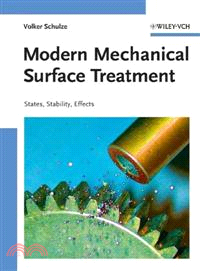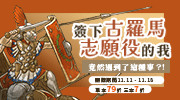Modern Mechanical Surface Treatment - States, Stability, Effects
商品資訊
ISBN13:9783527313716
出版社:John Wiley & Sons Inc
作者:Schulze
出版日:2005/11/18
裝訂/頁數:精裝/375頁
定價
:NT$ 10575 元優惠價
:90 折 9518 元
若需訂購本書,請電洽客服 02-25006600[分機130、131]。
商品簡介
作者簡介
名人/編輯推薦
目次
相關商品
商品簡介
The only comprehensive, systematic comparison of major mechanical surface treatments, their effects, and the resulting material properties. The result is an up-to-date, full review of this topic, collating the knowledge hitherto spread throughout many original papers.
The book begins with a description of elementary processes and mechanisms to give readers an easy introduction, before proceeding to offer systematic, detailed descriptions of the various techniques and three very important types of loading: thermal, quasistatic, and cyclic loading. It combines and correlates experimental and model aspects, while supplying in-depth explanations of the mechanisms and a very high amount of exemplary data.
The book begins with a description of elementary processes and mechanisms to give readers an easy introduction, before proceeding to offer systematic, detailed descriptions of the various techniques and three very important types of loading: thermal, quasistatic, and cyclic loading. It combines and correlates experimental and model aspects, while supplying in-depth explanations of the mechanisms and a very high amount of exemplary data.
作者簡介
Volker Schulze heads the Manufacturing Processes and Component Behaviour section of the Institute for Materials Science and Engineering I at Karlsruhe University since 2004.
He began his studies in Mechanical Engineering at Karlsruhe University in 1985, took his master's degree in 1990 and obtained his doctorate of engineering in 1993. He became head of the Materials Testing Laboratory at the institute in 1995.
Since 2002, he serves as head of the International Scientific Committee on Shot Peening, and has recently completed his lecture qualification (Habilitation) on surface layers after mechanical surface treatments. His main working areas include lecturing on Materials Science and Engineering and conducting research focused on studies of
- surface layer characteristics after different production processes,
- residual stress stability at thermal, quasistatic, cyclic and combined loading conditions, and
- the simulation of production processes.
He began his studies in Mechanical Engineering at Karlsruhe University in 1985, took his master's degree in 1990 and obtained his doctorate of engineering in 1993. He became head of the Materials Testing Laboratory at the institute in 1995.
Since 2002, he serves as head of the International Scientific Committee on Shot Peening, and has recently completed his lecture qualification (Habilitation) on surface layers after mechanical surface treatments. His main working areas include lecturing on Materials Science and Engineering and conducting research focused on studies of
- surface layer characteristics after different production processes,
- residual stress stability at thermal, quasistatic, cyclic and combined loading conditions, and
- the simulation of production processes.
名人/編輯推薦
"...to give readers an easy introduction... It combines and correlates experimental and model aspects, while supplying in-depth explanations of the mechanisms and a high amount of exemplary data." Metall
目次
1 Introduction.
2 Procedures of Mechanical Surface Treatments.
2.1 Shot Peening.
2.1.1 Definition and Delimitation of Procedure.
2.1.2 Application Examples.
2.1.3 Devices, Tools and Important Parameters.
2.2 Stress Peening.
2.2.1 Definition and Delimitation of Procedure.
2.2.2 Application Examples.
2.2.3 Devices, Tools and Important Parameters.
2.3 Warm Peening.
2.3.1 Definition and Delimitation of Procedure.
2.3.2 Application Examples.
2.3.3 Devices, Tools and Important Parameters.
2.4 Stress Peening at Elevated Temperature.
2.5 Deep Rolling.
2.5.1 Definition and Delimitation of Procedure.
2.5.2 Application Examples.
2.5.3 Devices, Tools and Important Parameters.
2.6 Laser Peening.
2.6.1 Definition and Delimitation of Procedure.
2.6.2 Application Examples.
2.6.3 Devices, Tools and Important Parameters.
3 Surface Layer States after Mechanical Surface Treatments.
3.1 Shot Peening.
3.1.1 Process Models.
3.1.2 Changes in the Surface State.
3.2 Stress Peening.
3.2.1 Process Models.
3.2.2 Changes in the Surface State.
3.3 Warm Peening.
3.3.1 Process Models.
3.3.2 Changes in the Surface State.
3.4 Stress Peening at elevated Temperature.
3.5 Deep Rolling.
3.5.1 Process Models.
3.5.2 Changes in the Surface State.
3.6 Laser Peening.
3.6.1 Process Models.
3.6.2 Changes in the Surface State.
4 Changes of Surface States due to Thermal Loading.
4.1 Process Models.
4.1.1 Elementary Processes.
4.1.2 Quantitative Description of Processes.
4.2 Experimental Results and their Descriptions.
4.2.1 Influences on Shape and Topography.
4.2.2 Influences on Residual Stress State.
4.2.3 Influences on Workhardening State.
4.2.4 Influences on Microstructure.
5 Changes of Surface Layer States due to Quasi-static Loading.
5.1 Process Models.
5.1.1 Elementary Processes.
5.1.2 Quantitative Description of Processes.
5.2 Experimental Results and their Descriptions.
5.2.1 Influences on Shape and Deformation Behavior.
5.2.2 Influences on Residual Stress State.
5.2.3 Influences on Workhardening State.
5.2.4 Influences on Microstructure.
6 Changes of Surface States during Cyclic Loading.
6.1 Process Models.
6.1.1 Elementary Processes.
6.1.2 Quantitative Description of Processes.
6.2 Experimental Results and their Descriptions.
6.2.1 Influences on Residual Stress State.
6.2.2 Influences on Worhardening State.
6.2.3 Influences on Microstructure.
6.3 Effects of Surface Layer Stability on Behavior during Cyclic Loading.
6.3.1 Basic Results.
6.3.2 Effects on Cyclic Deformation Behavior.
6.3.3 Effects on Crack Initiation Behavior.
6.3.4 Effects on Crack Propagation Behavior.
6.3.5 Effects on Fatigue Behavior.
7 Summary.
Acknowledgments.
Index.
2 Procedures of Mechanical Surface Treatments.
2.1 Shot Peening.
2.1.1 Definition and Delimitation of Procedure.
2.1.2 Application Examples.
2.1.3 Devices, Tools and Important Parameters.
2.2 Stress Peening.
2.2.1 Definition and Delimitation of Procedure.
2.2.2 Application Examples.
2.2.3 Devices, Tools and Important Parameters.
2.3 Warm Peening.
2.3.1 Definition and Delimitation of Procedure.
2.3.2 Application Examples.
2.3.3 Devices, Tools and Important Parameters.
2.4 Stress Peening at Elevated Temperature.
2.5 Deep Rolling.
2.5.1 Definition and Delimitation of Procedure.
2.5.2 Application Examples.
2.5.3 Devices, Tools and Important Parameters.
2.6 Laser Peening.
2.6.1 Definition and Delimitation of Procedure.
2.6.2 Application Examples.
2.6.3 Devices, Tools and Important Parameters.
3 Surface Layer States after Mechanical Surface Treatments.
3.1 Shot Peening.
3.1.1 Process Models.
3.1.2 Changes in the Surface State.
3.2 Stress Peening.
3.2.1 Process Models.
3.2.2 Changes in the Surface State.
3.3 Warm Peening.
3.3.1 Process Models.
3.3.2 Changes in the Surface State.
3.4 Stress Peening at elevated Temperature.
3.5 Deep Rolling.
3.5.1 Process Models.
3.5.2 Changes in the Surface State.
3.6 Laser Peening.
3.6.1 Process Models.
3.6.2 Changes in the Surface State.
4 Changes of Surface States due to Thermal Loading.
4.1 Process Models.
4.1.1 Elementary Processes.
4.1.2 Quantitative Description of Processes.
4.2 Experimental Results and their Descriptions.
4.2.1 Influences on Shape and Topography.
4.2.2 Influences on Residual Stress State.
4.2.3 Influences on Workhardening State.
4.2.4 Influences on Microstructure.
5 Changes of Surface Layer States due to Quasi-static Loading.
5.1 Process Models.
5.1.1 Elementary Processes.
5.1.2 Quantitative Description of Processes.
5.2 Experimental Results and their Descriptions.
5.2.1 Influences on Shape and Deformation Behavior.
5.2.2 Influences on Residual Stress State.
5.2.3 Influences on Workhardening State.
5.2.4 Influences on Microstructure.
6 Changes of Surface States during Cyclic Loading.
6.1 Process Models.
6.1.1 Elementary Processes.
6.1.2 Quantitative Description of Processes.
6.2 Experimental Results and their Descriptions.
6.2.1 Influences on Residual Stress State.
6.2.2 Influences on Worhardening State.
6.2.3 Influences on Microstructure.
6.3 Effects of Surface Layer Stability on Behavior during Cyclic Loading.
6.3.1 Basic Results.
6.3.2 Effects on Cyclic Deformation Behavior.
6.3.3 Effects on Crack Initiation Behavior.
6.3.4 Effects on Crack Propagation Behavior.
6.3.5 Effects on Fatigue Behavior.
7 Summary.
Acknowledgments.
Index.
主題書展
更多
主題書展
更多書展今日66折
您曾經瀏覽過的商品
購物須知
外文書商品之書封,為出版社提供之樣本。實際出貨商品,以出版社所提供之現有版本為主。部份書籍,因出版社供應狀況特殊,匯率將依實際狀況做調整。
無庫存之商品,在您完成訂單程序之後,將以空運的方式為你下單調貨。為了縮短等待的時間,建議您將外文書與其他商品分開下單,以獲得最快的取貨速度,平均調貨時間為1~2個月。
為了保護您的權益,「三民網路書店」提供會員七日商品鑑賞期(收到商品為起始日)。
若要辦理退貨,請在商品鑑賞期內寄回,且商品必須是全新狀態與完整包裝(商品、附件、發票、隨貨贈品等)否則恕不接受退貨。
























